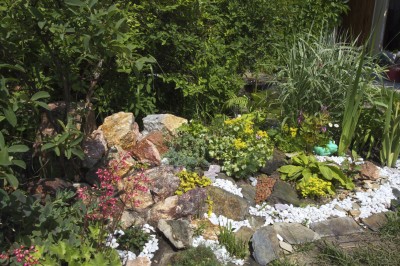






By Mary Dyer, Master Naturalist and Master Gardener
What is a rockery? In simple terms, a rockery is an arrangement of rocks and alpine plants. Rockeries are focal points in the landscape, often created to take advantage of a naturally sloped or terraced area. Read on for more info on how to make a rockery of your own.
Many gardeners prefer to construct a rockery in autumn, and then plant it in spring so the roots have time to establish before hot weather.
You need several large rocks to serve as anchors for your rockery. Collect the rocks yourself, or purchase them from a rock dealer, quarry, or landscape company. If possible, use interestingly shaped rocks that are native to your area. Rocks with lichens or moss add texture, color, and a feeling of permanence.
Once you have your large rocks, you can plan your rockery. Rockery garden design can be tricky, but the job is easier if you outline a plan on paper first. Be sure to take rock size into consideration, and then draw plants proportionately. A rockery should look like a natural, organic part of the landscape.
When you’ve designed a basic garden plan, purchase plants from a greenhouse or from a nursery that specializes in Alpine plants.
Alpine plants are perennials that grow in high, rocky areas. The choice of suitable plants is huge. For example, many spring-blooming bulbs do well in rockeries. The following garden rockery plants will help get you started:
You can also plant a few dwarf conifers, such as juniper or pine, which add year-round color to your rockery. For spring and summer color, consider blooming, mounding shrubs such as azalea.
Although rockeries are often located in full sunlight, you can build your rockery in partial shade. Select plants accordingly and consider the growing needs for each plant. For example, if your plants require afternoon shade, don’t plant them in full sunlight. Don’t plant water-loving plants alongside drought-tolerant plants.
Consider the soil in the area before constructing your rock garden. Alpine plants require loose, well-drained soil, so if your soil is poor or compacted, dig in several inches of bark or compost to improve soil quality and drainage.
Bury your large rocks according to your diagram. Be sure each rock is buried to a soil depth of at least one-third to keep the rock securely in place.
Once the large rocks are in place, arrange plants and smaller rocks. Set the plant pots and rocks, and then stand back and take a look. Experiment and rearrange until you like the looks of the rockery, then secure the rocks and plant your Alpine plants. Finish by surrounding the plants and rocks with a layer of gravel or pebbles.
Give your rockery regular attention to keep it in tip-top shape. Water regularly and weed once every week. Trim overgrown plants and divide perennials as needed – usually once every three to four years.
What Is A Root Zone: Information On The Root Zone Of Plants
What Are Botanical Gardens – Botanical Garden Information
What Is A Hard Frost: Information On Plants Affected By Hard Frost
Indoor Atrium Garden: What Plants Do Well In An Atrium
What Is An Organic Garden: Information On Growing Organic Gardens
Copyright © www.100flowers.win Botanic Garden All Rights Reserved